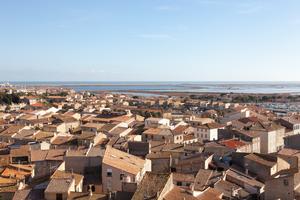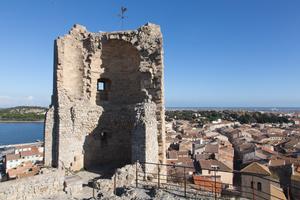Gruissan on the Aude Coast
Gruissan, on the Mediterranean coast of the Aude, has three distinct parts: Gruissan village, the original settlement, Gruissan Port, the more recently constucted marina development, and Gruissan les Chalets, an area of timber chalets on stilts built on the dunes beyond the marina area.

Gruissan Port marina
One of many craft which moor up at Gruissan Port. It's full to capacity in the winter.

Yachts at Gruissan Marina
A safe haven, in winter thousands of yachts and other pleasure craft are moore up at Gruissan Port.

The Etang do Gruissan
Looking across the Etang from the Tour Barberousse above Gruissan Village. Running along the edge of it is one one the several un-named waterways around this area of inland seawater.

Pyrenees Foothills across the Etang d l'Ayrolle
A causeway carrying the road between the Etang d l'Ayrolle and Etang de Bages et Sigean is the most scenic route to Port la Nouvelle, and the shortest if travelling from Gruissan.
This south-westerly evening view across the marshy edges of the Etang looks towards the foothills of the Pyrenees.

Evening view of Gruissan and Tour Barbaroussa
Just before sunset, a view across the Etang du Gruissan towards Gruissan Village and the ruin of the Tour Barbaroussa on its limestone eyrie.

Coastal wilderness near Gruissan
The Salin de Reprise covers hundreds of acres, and is a strange half-sea, half land maze. Many of the salt beds are no longer in use, so it's an eery, unspoilt place.

Would you like salt with that?
The Salin de Reprise yields so much salt that they store it outside in a giant pile of several thousand tons.

Across the Salin towards Port la Novelle
Looking across some of the now-unused salt beds of the Salin de Reprise towards Port la Nouvelle.

Looking in inland from the Salin de Reprise
A view of the salt-processing works of San Martin d'Est, and the massif of La Clape beyond.

Water level marker, Salin de Reprise
At Saint Martin d'Est, just south of Gruissan, are the salinieres (salt basins) of the Salin de Reprise. Partly in use, most are abandoned, although salt production continues here - there is no shortage of the stuff.

Etang du Gruissan
The Etang du Gruissan is connected with, but protected from the open sea. Shellfish are cultivated here, and small boats are used to set and tend their nets.

Gruissan port is modern
Around the Etang du Grazel, just north of Gruissan Village, is Gruissan Port. This is an entirely modern development, using the Etnag as safe shelter for a marina, which is surrounded by modern apartments.

Towards Gruissan Port from the village
The Tour de Barbaroussa is the sole high point for a fair distance, and gives a wide view over Gruissan, the coast, and inland across the Etang towards Narbonne.

Tour Barberousse, Gruissan
Originally built in the late 10th Century to guard the Etang du Gruissan, which leads almost to Narbonne, the stone castle stands on limestone outcrop which towers over the village of Gruissan.

Front door in Gruissan
Found widely in France are door-knockers in the shape of a hand. This one, on a door with brown, peeling paint, is in Gruissan.

Canal du Grazel at Gruissan
Linking the Etang du Gruissan with the sea is the short Canal du Grazel.

Gruissan and the Medieterranean coast
A view over Gruissan to the salinieres - salt lakes - and the Mediterranean beyond.

Old Town Gruissan
A view over the rooftops of Gruissan old town from the elevated setting of the castle ruin.

View over Gruissan from the Chateau
The old part of this Mediterranean port is overlooked by the chateu ruin

